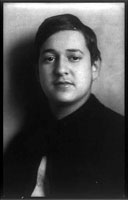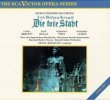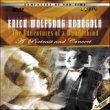Erich Korngold
(1897-1957)
Today, the soundtrack of a film is often as crucial to the film’s success as the film itself, but this was not always the case. One of the first to exploit the musical potential of film was Erich Korngold. In such films as The Adventures of Robin Hood (1938) and The Sea Hawk (1940), the Austrian composer successfully adapted the late-Romantic musical language of his operas and songs to the screen. For a time, the operas and songs themselves seemed to have been forgotten. In the last ten years, however, more and more of Korngold’s vocal works have been recorded and performed, with Die tote Stadt (1920) receiving particular attention.
 The Child Prodigy The Child Prodigy
Erich Korngold was born on May 29, 1897, in Brünn (then the capitol of Moravia, now known as the city of Brno in the Czech Republic). His mother, Josephine, was an excellent amateur pianist and singer. Although Korngold’s father, Julius, had earned a law degree, he spent most of his time as a music critic and newspaper editor at a paper in Brünn. An essay he wrote championing Brahms came to the attention of Brahms’s friend, Eduard Hanslick. Hanslick was chief music critic at the Neue Freie Presse (New Free Press) in Vienna, and Julius Korngold became his protégé. As a result, the family moved to Vienna in 1901. Upon Hanslick’s death in 1904, Julius Korngold assumed his post.
Julius Korngold named both of his sons after favorite composers. The elder son, Hanns Robert, was named in Schumann’s honor, and Erich’s middle name, Wolfgang, was a tribute to Mozart. In Erich’s case, this decision proved portentous. The child showed prodigious musical ability before the age of six, when his sense of pitch and startling understanding of harmony compelled Julius to engage a relative for piano lessons. It soon became clear that Erich had extraordinary talent as a pianist, improvised brilliantly, and remembered everything he heard or played.
Erich’s first compositions date from 1904, and a 1906 cantata called Gold became a catalyst for his early renown. This work, lost later in a series of Nazi-led property confiscations, is known to have been a setting of text by one of Erich’s young classmates. Its quality inspired Julius to arrange lessons in harmony and counterpoint for Erich with Robert Fuchs, a professor at the Vienna Conservatory whose other notable students included Mahler, Wolf, Sibelius, and Zemlinsky. Under Fuchs’ supervision, Erich produced a number of piano pieces as well as songs.
In the summer of 1906, Julius took Erich to visit Gustav Mahler, of whom the elder Korngold was a great supporter. As Erich played his cantata (Gold) for the great composer, Mahler proclaimed the boy a genius and suggested that Julius should take him to composer Alexander von Zemlinsky (also known later as the only formal instructor of Arnold Schoenberg). Lessons with Zemlinsky did not take place until 1908 but were thereafter extremely important for the young composer’s progress. Korngold’s first works under Zemlinsky’s tutelage included a piano suite titled Don Quixote: Six Characteristic Pieces (1908) and his Piano Sonata No. 1 (1908).
The Wunderkind Composer
At the end of 1908, Korngold began work on what would become the ballet-pantomime Der Schneemann (The Snowman). His father provided some of the plot structure, which incorporated elements of commedia dell’arte. The music, however, was all Erich’s, and was of such an astonishingly high quality that Julius Korngold began to consider making his son’s talents public. First, he had the Sonata and Don Quixote printed and sent privately to eminent figures in music, including Richard Strauss and Alban Berg.
Soon there were newspaper articles by prominent critics announcing Erich Korngold as a new child prodigy. The wave of press led to the first public performance of his work, a production at the prime minister’s palace, in which Erich Korngold and pianist Richard Pahlen played a four-hand arrangement to accompany dancers from the Imperial Ballet. This event took place in April 1910 and made quite a stir. In the fall, Der Schneemann was performed at the Vienna Court Opera, with orchestrations provided by Zemlinsky. The young composer took an active part in the preparation of this production. Its enthusiastic reception effectively launched Korngold’s career at the age of thirteen.
Korngold was soon to begin a period of travel, performance, and public appearances throughout Germany, Austria, and Hungary as a Wunderkind, in the sense associated with Mozart’s childhood. His Piano Trio in D Major (1909) was performed in Munich shortly after the ballet’s success, with conductor Bruno Walter at the piano. Korngold’s first orchestral work, the Schauspiel Ouvertüre (Overture for a Play, 1911), along with the Sieben Mârchenbilder (1910) for piano and his Piano Sonata No. 2 in E Major (1910) earned him further attention, especially from notable figures such as theatrical director Max Reinhardt and pianist Artur Schnabel. Both of these men were favorably impressed with Korngold’s compositions, and were to become champions of the young composer.
Though much of the buzz surrounding Korngold’s early fame was positive, there were detractors. Some were rivals of Julius Korngold in the sphere of music criticism, and some harbored resentment against the prodigy regarding his Jewishness. While the Korngold family was not deeply religious, this issue would resurface later, and with more serious implications.
Regardless of such tensions, the boy composer was a sensation, with his Schauspiel Ouvertüre and pieces of the ballet performed as far away as London. By 1914 the ambitious Sinfonietta in B Major had made a splash in the U.S. Korngold completed the Sinfonietta in 1912, followed by the Sonata in G Major for violin and piano (1912). Soon he made the decision to return to writing for the stage, this time producing two operas, the comedy Der Ring des Polykrates and the tragedy Violanta (both 1914). The new director of the Vienna Court Opera, Hans Gregor, heard Korngold play his operas at a family friend’s salon, and offered a contract. The operas’ 1916 premiere (together, as they were each relatively brief) initiated a series of other productions throughout Austria, Hungary, Germany, Switzerland, and Scandinavia. They remained in the repertory until the 1930s.
Setting the Stage
Korngold was of an age to be conscripted in 1917, when the First World War was at its height. Although he was exempted from service at the front lines, he was assigned as music director to a Viennese-based Austrian regiment. During the war, he also conducted and performed at charity events for war orphans and others. At the same time, he began work on what would be his greatest international success: the opera Die tote Stadt (1920). Both the opera houses of Hamburg and Cologne requested the honor of producing its debut, and in the end, both gave concurrent premieres in December 1920. Vienna followed, and the opera was met with acclaim. It soon attracted international admiration, receiving performances throughout Europe and as far away as New York.
In 1921, Korngold spent a season guest conducting at the Hamburg Opera. Upon his return to Vienna, he completed his Piano Quintet in E Major (1921). He also began work on his String Quartet No. 1 (1921-3) and his fourth opera, Das Wunder der Heliane (not finished until 1927). Korngold was married in April 1924 to Luise (Luzi) von Sonnenthal, a young actress and singer with whom he had fallen in love in 1917. Their first son, Ernst Werner, was born in March 1925, and their second, Georg, in December 1928.
The composer’s career suffered some setbacks in the 1920s. Because of a feud between Julius Korngold and Richard Strauss, demonstrations were directed against both Korngolds. In addition, Nazi outbursts against Jews disrupted a 1922 production of Die tote Stadt in Munich.
Nevertheless, the composer had staunch supporters. With Max Reinhardt, Korngold worked in the late 1920s to adapt several operettas by Johann Strauss and Jacques Offenbach. One of these projects, a refurbished version of Offenbach’s La Belle Hélène, was so successful in its German adaptation that it went on to be selected for an English production in 1932. Reinhardt also enlisted Korngold for a film version of the operetta. This collaboration was to prove significant in the next phase of Korngold’s career.
The Symphonic Score
After Hitler became chancellor in 1933, the composer received fewer invitations to conduct or to adapt music for operetta productions. When Reinhardt, in Los Angeles at the time, requested that Korngold join him on a film version of A Midsummer Night’s Dream, he decided to go. This project, a Warner Brothers movie starring, among others, James Cagney, Olivia de Havilland, and Mickey Rooney, began filming in late 1934. While the famous incidental music by Mendelssohn was at the core of Korngold’s work on the film, he created a much larger, more integrated score with other Mendelssohn material and some of his own contributions. He broke new ground with this picture, with an entirely new approach to film music: the symphonic score.
After a brief trip home to Vienna, Korngold returned to Hollywood for his next score, Warner Brothers’ Captain Blood (1935), which starred Errol Flynn and Olivia de Havilland. Further cinematic projects included four in 1936: Anthony Adverse, Give Us This Night, The Green Pastures, and a song for Rose of the Rancho. His score for Anthony Adverse won an Academy Award. At the ceremony, to Korngold’s dismay, the Oscar was handed to Leo Forbstein, the head of Warner Brothers’ music department. Korngold was furious, as he initially thought that Forbstein was claiming credit for Korngold’s work. In response to the misunderstanding, the Academy thereafter awarded the Oscar to composers rather than to the head of a film’s music department.
The Korngolds had taken time between film projects to return to Vienna. In 1937 he was trying vainly to arrange production of his fifth opera, Die Kathrin, when he received a telegram from Reinhardt inviting him back to Hollywood. (The opera eventually debuted in Stockholm in 1939, but anti-Semitic politics doomed it to obscurity.) The family left for California right away so that Korngold could begin work on the score for The Adventures of Robin Hood.
Because of this project, the Korngolds missed the Anschluss (the annexation of Austria to Germany) and evaded certain death. Julius had foreseen the danger and had obtained a visitor’s visa to the U.S. a few weeks before Hitler marched into Austria. Thus, he and the rest of the family narrowly escaped to Switzerland, then to America. The Korngolds joined a long list of European musical luminaries seeking refuge in Los Angeles; Arnold Schoenberg and his family became particularly close friends of the Korngolds.
Though Korngold initially found the fast pace of Robin Hood daunting and tried to back out, he finally relented. The film was both a musical and a cinematic triumph, earning Korngold his second Oscar. In this score, the composer created a new musical form incorporating techniques similar to those traditionally found in opera and symphonic poems, such as leitmotif (musical motives associated with individual characters). Film composition today remains greatly indebted to Korngold’s style.
Over the next decade and a half, Korngold accepted a few projects outside of Hollywood, such as conducting in San Francisco and collaborating once more with Max Reinhardt on a 1942 adaptation of Die Fledermaus for a New York group called the New Opera Company. He also completed and conducted for twelve more film scores, including the now beloved music for The Sea Hawk (1940), Kings Row (1941), The Sea Wolf (1941), The Constant Nymph (1942) and Of Human Bondage (1944). Of Human Bondage proved a discouraging experience for Korngold, as the film’s quality faltered and his own work somehow did not fit well.
Last Years: Returning to the Concert Hall and the Stage
This disappointment was compounded by two painful losses, Reinhardt’s death in 1943 and Julius Korngold’s death in 1945. In his grief, Korngold turned again to other genres, composing the String Quartet No. 3 in D Major (1944-5). Nevertheless, he could not entirely abandon his recent past and included music from The Sea Wolf in the Quartet’s third movement. He worked on a musical comedy, Die stumme Serenade (1946, premiered on radio in 1951 and on stage in 1954). In addition, he revised his Violin Concerto, originally written in 1937, for a 1947 premiere by the renowned violinist Jascha Heifetz.
A heart attack in 1947 prevented Korngold from taking on several further film offers, but while recuperating he worked on his Symphonic Serenade in B-flat major for string orchestra. A set of songs, published as Five Lieder (1948), contains material from many of his scores. The Serenade eventually received its first performance under Wilhelm Furtwängler, conducting the Vienna Philharmonic in 1950.
For this premiere, the Korngolds returned home to Vienna for the first time since the end of the War. Things were bleak; the city was still in ruins, and they had to go to court over their old house, which was now occupied by strangers. A new production of Kathrin failed.
The composer decided to go back to Hollywood in 1951. There he finished his Symphony in F-sharp (1952), and what would be his final song, “Sonett für Wien” (Sonnet for Vienna, 1953). In response to a commission requesting works for American school orchestras, he wrote a Theme and Variations for Orchestra (1953) and Straussiana for Orchestra.
In 1954, Korngold was asked to arrange the music for a German film about Richard Wagner (Magic Fire, with a score using Wagner’s own material) and returned to Europe to work on it, as well as to oversee the premiere of the Symphony in F-sharp. Both of these experiences were less than satisfying for the composer, and he feared that his work was entirely forgotten in Europe.
In May 1955, Korngold and his family returned to America for good. His final project was the revision of a previous Die Fledermaus adaptation, this time for televised broadcast by NBC. He suffered a severe stroke in October 1956, and though he partially recovered, he endured many physical and emotional difficulties before his death on November 29, 1957. He was buried in the Hollywood Cemetery, near other legends of the silver screen’s golden age.
References:
Carroll, Brendan G.: ‘Korngold, Erich Wolfgang', Grove Music Online ed. L. Macy (Accessed 16 May 2006), <http://www.grovemusic.com>
Carroll, Brendan G. The Last Prodigy: A Biography of Erich Wolfgang Korngold. Portland, Oregon: Amadeus Press, 1997.
Cooke, Mervyn: ‘Film Music’, Grove Music Online ed. L. Macy (Accessed 24 September 2006), <http://www.grovemusic.com> |



